I don't want you to take these anti-learning concepts on faith.
In order the create presentations that translate into real performance, you must be able to spot the nuances that trigger anti-learning. Faith is not enough.
We need to shift your mindset from: "Knowledge is knowledge," to: "Format matters."
We're in trouble.
When I say, "Knowledge is knowledge," it's more convincing than, "Format matters." And I know that format does matter.
We need a good example. Let's start with a childhood learning subject — the alphabet.
The Alphabet
The alphabet is classic anti-learning material. The series of letters is way too long for regular recall, and listing them as a stream of letters has no discernible pattern.
The alphabet is difficult to learn and impossible to use in rapid decision-making.
Comments:
The point is that we used a jingle to learn it. AB..CD...EFG...I can still hear the tune in my head. My guess is that we used the jingle to figure out if Q came before R…for years. That may seem oddly effective, but humming the tune while giving a fast-paced presentation isn't good enough.
(And no, I'm not going to admit that I hum the jingle when I alphabetize my research notes.)

The alphabet learning process isn't unique. We've used jingles and rhymes for remembering anti-learning pattern material throughout our education.
And it works. "Fall forward, spring back," helps with setting our clocks; "April, May…have thirty-one," helps with our calendar management.
Comments:
There are limits to jingle based recall. You don't want your surgeon using a rhythm to figure the best knot to tie off your stitches. If a soldier needs to hum a tune to know when to dive for cover, he's in trouble.
Well-constructed, properly patterned information flows more naturally.
The Periodic Table
For example:
Anyone working in the physical sciences knows the dynamics of the Periodic Table — without resorting to jingles or rhymes. The layout and structure are key. It's not the data; it's the pattern.
The Ideal
The ideal would be to shape the learning material to fit the end use. Teachers would still be professional and students would still need to pass exams, but with a closer tie between knowledge and application, real-life performance would be easier.
Comments:
Good questions. Most times you don't have the luxury of designing your own information. Anytime you have time constraints, you'll feel forced to study the material as it's presented.
In addition, even with information designed from scratch, it's not easy to weave precise anti-learning patterns. With a potentially overwhelming list of material to fix, you will need to be selective.
What's next?
You now have a growing sense for how presentations can differ. We need to add detail to that understanding.
The next section will examine pattern design in a more complex setting — a grocery store.
Following that, we'll untangle the experiment that led to the anti-learning concept. Then, armed with an understanding of the pattern / performance connection, we'll look at how to build your own high-performance training material.
| AWSS Home | Previous Section | Next Section | Feedback: James Davis
